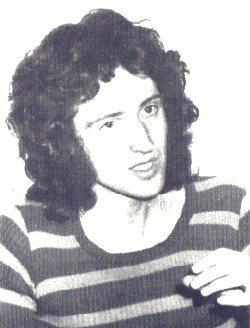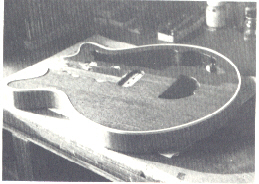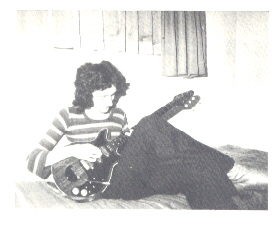
Brian May interview from 1973
This article appeared in "Guitar" in August 1973. The first interview that Brian May did with a guitar magazine.
Transcribed by Mark Reynolds
The man who made his guitar:
Brian May, lead guitarist of Queen, talks to Jeffrey
Pike

Queen is a four-man band for whom people in the know are prophesying
big things. Their music is fairly heavy, but with more definable melody
and harmonies than many rock bands. Vocally, they can belt out a strong
three-part harmony which often pushes the instruments into the background.
The talented lead guitarist of Queen is a young man with a physics
degree, who must be unique amongst rockers in that he built the solid guitar
he uses on stage. I asked Brian May why he made it: "Partly from the interest
of doing it-I'd always been interested in making things, like I was interested
in stereo photography and I made stereo viewers and things like that. And
I made a steel guitar, a very simple thing. So when I started playing lead
guitar in a group, I needed a good electric guitar. And I just couldn't
afford one! I think I just wanted to make one that was better than any
of the things that anybody had, to put in all the things I would like to
have on a guitar."
So what was wrong with the guitars that were available at the time? "Apart from the fact that I couldn't afford them? Lots of things. For instance, tremolo arms were very much in vogue at the time (1963-4), and a lot of guitars suffered a bit of neck bending because of all the extra strain. I wanted a truss rod that was genuinely adjustable, so it would be perfectly stressed.
"Also, tremolos tended not to return exactly to their original position when you pressed them. There was always a danger of playing out of tune. So I wanted something that would return accurately. This thing uses a knife-edge principle which has got virtually no friction. The strings are attached to a plate which pivots on the knife-edge, and the pull of the strings is balanced by a couple of springs in compression at the back- the springs came from motorbike valves." Our picture shows the proto-type tremolo arm and plate, which Brian rigged up to test the effects of string tension.

The bridge is of an original design. "It's similar to the Micromatic: you can change the string length of individual strings, to compensate for wear and tear on the strings and to keep the octaves exactly right. But the new feature is that each one of these little separate bridges is a roller, so when you move the tremolo arm they roll with the string: you don't get any string wear that way. Thus they keep their tone for a long time and don't break at the bridge."
The May guitar is not just a collection of tricky mechanical devices. Brian also knows what's what in the fields of electronics, acoustics and resonance- and of course he's a musician. So the handsome cherry-red body of his guitar is more than just a plank of wood for mounting elaborate metalwork on: it was lovingly designed to give exactly the resonant qualities the designer wanted. I'd heard a rumour that it was made out of an old fireplace, but then pop publicists will tell you anything these days.
"No, that's quite true. This old fireplace just happened to be around; it's about 100 years old. It's laminated actually. The thing that takes the strain is oak, a square section, on to which is bolted the mahogany neck. The rest of the body is a softer wood, and it includes some acoustic pockets. All the parts are very closely coupled together, screwed and glued, so the whole thing acts as one resonator."
Acoustic pockets? "Yeah, I wanted to get some feedback assisted by the body. The pockets are roughly the size at which the air would resonate, around the middle of the guitar's frequency range. It worked out fairly well. This has a bit less feedback than a semi-acoustic guitar, but a bit more than a solid." The photographs of the guitar in the construction stage show clearly the size and shape of the acoustic pockets.

As you might have guessed by now, Brian also knew exactly what he wanted from his pick-ups, so instead of buying a factory-made set, he designed and constructed his own. "I was determined to make pick-ups that didn't whistle. You know, you can play electric guitar in three ways: first, as an amplified acoustic guitar, at fairly low volume, with all the natural decay of notes. Then you can turn it up to the level where the feedback just about counteracts the friction in the system, so you can sustain the note indefinitely- the sort of Clapton thing. Or you can go one stage further and turn it up so that the loop gain is greater than One: then the thing is bursting forth of its own accord all the time. That's the sort of level I like to play at. But it's got to burst forth at the frequencies you want it to burst forth, not with some nasty whistle somewhere up the top.

"The sound from these pick-ups is fairly warm, with a slight edge to it. Though it's possible to take the warmth out of it by anti-phasing. Yes, there's a phase reversal switch for each pick-up, so you can make any pick-up work against the other two." Next to the phasing switches is a little bright red two-way switch. I asked Brian what it's for. "That's the on-off switch for a built in fuzz box! Actually, I don't use it so much these days. Occasionally it's nice for an effect, but at the levels at which I play I don't need the fuzz for sustain, and I don't particularly like the fuzz sound now."
I wondered if he now regards the guitar as perfect, if it does everything he wants from the guitar. "I think so, yes. If I was designing it again, I'd have the neck slightly thinner to get a little bit more access. But in fact I've got so used to this neck now that anything else feels a bit strange. I've got a Stratocaster - it's an old pre-CBS model, a good one - and I've done it up a bit so it's a really nice guitar. I get on well with it, but after a while I always come back to this."
Brian caressed his guitar lovingly and tried to define what the guitar-makers greatest asset is . . . should he be primarily a woodworker, an electronics wizard, a musician? "I think the most important thing must be to have a feel for what you're aiming for, and not to lose sight of the end product and get absorbed in things that don't make any difference. In other words, you need a feel for the sort of music it's going to be playing. But then, you need a bit of every sort of skill. For instance, it doesn't have to be finished that well in order to perform its function, but you want it to be. Like, I spent a lot of time inlaying these position markers on the fingerboard - they're made from old mother-of-pearl buttons incidentally. That took ages, but to me it's worth it. I'm glad it's something that's nice to look at as well as to play.
Having made one instrument that's nice to look at and nice to play, Brian is in no hurry to make another one. "I can't see myself making another guitar for a few years anyway. There's so much work involved, and I just don't have the time now. It's difficult to know where to draw the line: you can get so keen on making things that you want to make everything. Then you get to the point where you're spending too much time on it instead of playing music."
Which is not to say that Brian May hasn't spent a lot of time making things. He built the very clever tape echo unit he uses with Queen, and has made several amplifiers. But doesn't use them. "I never much liked the amps I made. I suspect you can't really design the sound of an amplifier - you just try and try till you find something that's exactly right. I find the old AC30s are just right for me. I use two of those on stage, three if it's a big place, straight, coupled together. They're miked into the PA, so I can vary the sound a bit there.
"I really love the AC30s very much. I bought two of mine for about twenty
quid each five years ago. When I tried to get another one last year, they
were asking about sixty for it! It's incredible how popular they've become
again. But they are really good - and the older they are, the better. The
really old ones were built more solidly, and the old speakers seem
to respond better. A transistor amp doesn't really work for this sort of
thing: it doesn't distort in the right way. It's designed to give a perfectly
linear response up to a certain point, then it distorts catastrophically.
Whereas a valve amp goes smoothly into distortion and you know exactly
where you're sitting."
I asked him about that echo unit. What does it do that other tape echoes can't? "The problem with conventional echo units is getting them synchronised with what you're playing. I wanted something I could synchronise without thinking. So this repeat box has the usual record head and playback head (both stereo heads, by the way) and erase head. The trick is that the playback head moves along a rail, to give greater or less delay in the playback. And it moves at exactly the same speed as the tape: it starts to move when you press a foot-button, and it stops when you press another one. So the time delay between when you play and when the echo comes can be exactly what you want, up to about 8 ½ seconds. Then you can use the stereo to feedback from one half to the other, for instance an eight-second delay on one channel and sixteen seconds on the other."
Their album "Queen" released last month, features the Brian May repeat box on several numbers. The guitars he uses on the record are the hand-made special and an old acoustic, which, needless to say, Brian has been unable to leave alone. "I put a new bridge on it and touched it up here and there, and it sounds very nice on the record. I've found, in common with a lot of other people, that you can spend an enormous amount of money on an acoustic guitar which may sound great on stage, but records like a lump of old socks. And yet some cheap old acoustic guitar might just have the sort of sound that records nicely. This one of mine has an amazingly crisp sound."
The release of a first album is always a traumatic moment for any band. Was Brian happy with what is on the record? "I'm quite pleased with it. But it's been such a long time - the band's been together for three years and most of the songs were written about three years ago. We just feel that, as a band, we've gone past what's on the album. We put it down in order to progress to different things.
"We like some of the stuff on it, but we sometimes fell into the trap of over-arrangement. You know, the songs changed over the years and some of them probably evolved too much. You can get so far into something that you forget what the song originally was. On a personal level, it was frustrating for me to take so long to get to this point. I wanted to record things with, for instance, tape echoes and multiple guitars five years ago. Now I've finally done it, but in the meantime so have other people! Which is a bit disappointing. But you have to get away from the idea that playing music is a competition. You should just keep on doing what you think is an interesting thing to do."